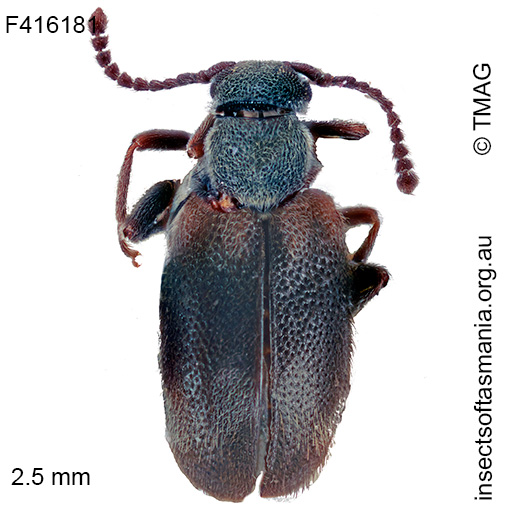
Aderus acaciae (a species of ant-like leaf-beetle)
Basis for Tasmanian occurrence
TMAG collections
Classification
Suborder: Polyphaga
Superfamily: Tenebrionoidea
Family: Aderidae
Morphology
Typical length (mm): 1.7
Flightedness: winged and assumed capable of flight
Source literature on morphology and taxonomy (*primary taxonomic source, where identified):
*Lea, A.M. (1917). Notes on some miscellaneous Coleoptera, with descriptions of new species. Part 3. Trans. Roy. Soc. S.A. 41: 121-322.
Ecology
Association with dead wood or old trees: obligately saproxylic
Ecological attributes: — Affiliated with older trees (Harrison, 2007) — May occupy logs or trunks of Eucalyptus obliqua, at least temporarily, since found having emerged within six years of felling (Grove et al., 2009).
Collection method(s) for TMAG material: — Baited trapping (funnel trap) — Emergence trapping from cut billets of Eucalyptus obliqua (Harrison, 2007) — Emergence trapping from log of Eucalyptus obliqua — Knockdown fogging of canopy of Nothofagus cunninghamii — Knockdown fogging of canopy of Nothofagus gunnii — Malaise trapping.
Source ecological literature:
Grove, S. et al. (2009). A long-term experimental study of saproxylic beetle … succession in Tasmanian Eucalyptus … logs… In: Fattorini, S. (Ed.), Insect Ecology and Conservation. Research Signpost, pp. 71-114.
Harrison, K.S. (2007). Saproxylic beetles associated with habitat features in Eucalyptus obliqua trees in the southern forests of Tasmania. PhD thesis, Dept. of Zoology, Univ. of Tasmania, Hobart.
Yee, M. (2005). The ecology and habitat requirements of saproxylic beetles native to Tasmanian wet eucalypt forests: potential impacts of commercial forestry practices. PhD thesis, Univ. of Tasmania, Hobart.

